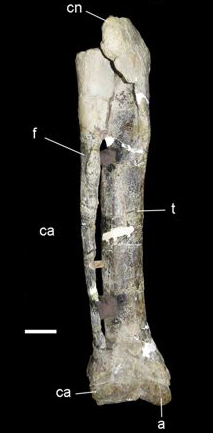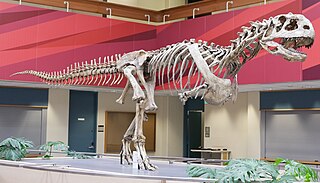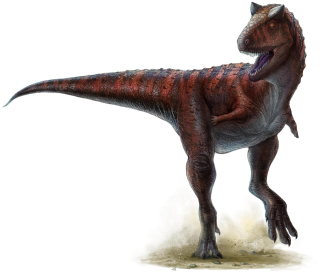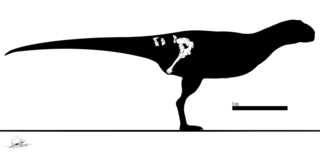
Abelisaurus is a genus of predatory abelisaurid theropod dinosaur alive during the Late Cretaceous Period (Campanian) of what is now South America. It was a bipedal carnivore that probably reached about 7.4 metres in length, although this is uncertain as it is known from only one partial skull.

Xenotarsosaurus is a genus of abelisaurid theropod dinosaur that lived during the Late Cretaceous of Argentina.

Aucasaurus is a genus of medium-sized abelisaurid theropod dinosaur from Argentina that lived during the Late Cretaceous of the Anacleto Formation. It was smaller than the related Carnotaurus, although more derived in some ways, such as its extremely reduced arms and almost total lack of fingers. The type skeleton is complete to the thirteenth caudal vertebra, and so is relatively well understood, and is the most complete abelisaurid yet described. However, the skull is damaged, causing some paleontologists to speculate that it was involved in a fight prior to death.

Abelisauroidea is a diverse superfamily of ceratosaurian dinosaurs, typically regarded as a Cretaceous group, though the earliest abelisaurid remains are known from the Middle Jurassic of Argentina and possibly Madagascar. Possible Abelisauridae remains were also discovered in Late Jurassic Tendaguru Beds in Tanzania.

Ilokelesia is an extinct genus of abelisaurid theropod, preserved in the layers of the earliest Late Cretaceous of the Huincul Formation, Neuquén Group, located near Plaza Huincul, Neuquén Province, Argentina. The specimen, consisting of very fragmentary elements of the skull and the axial and appendicular skeleton, was described by Rodolfo Coria and Leonardo Salgado in late 1998.

Quilmesaurus is a genus of carnivorous abelisaurid theropod dinosaur from the Patagonian Upper Cretaceous of Argentina. It was a member of Abelisauridae, closely related to genera such as Carnotaurus. The only known remains of this genus are leg bones which share certain similarities to a variety of abelisaurids. However, these bones lack unique features, which may render Quilmesaurus a nomen vanum.

Ekrixinatosaurus is a genus of abelisaurid theropod which lived approximately 100 to 97 million years ago during the Late Cretaceous period. Its fossils have been found in Argentina. Only one species is currently recognized, Ekrixinatosaurus novasi, from which the specific name honors of Dr. Fernando Novas for his contributions to the study of abelisaurid theropods, while the genus name refers to the dynamiting of the holotype specimen. It was a large abelisaur, measuring between 6.5 and 8 m in length and weighing 800 kg (1,800 lb).

Carnotaurinae is a subfamily of the theropod dinosaur family Abelisauridae. It includes the dinosaurs Aucasaurus, Carnotaurus. The group was first proposed by American paleontologist Paul Sereno in 1998, defined as a clade containing all abelisaurids more closely related to Carnotaurus than to Majungasaurus.

Carnotaurini is a tribe of the theropod dinosaur family Abelisauridae from the Late Cretaceous period of Patagonia. It includes the dinosaurs Carnotaurus sastrei; the type species, Aucasaurus garridoi, and Abelisaurus comahuensis. This group was first proposed by paleontologists Rodolfo Coria, Luis Chiappe, and Lowell Dingus in 2002, being defined as a clade containing "Carnotaurus sastrei, Aucasaurus garridoi, their most recent common ancestor, and all of its descendants."

Skorpiovenator is a genus of abelisaurid theropod dinosaur from the Late Cretaceous Huincul Formation of Argentina. It is one of the most complete and informative abelisaurids yet known, described from a nearly complete and articulated skeleton.

Rahiolisaurus is a genus of abelisaurid theropod dinosaur which existed in India during the Late Cretaceous period. It was described in 2010, based on fossils recovered from the Lameta Formation in the Indian state of Gujarat. These fossils include elements from at least seven different individuals and are believed to have been from the Maastrichtian stage, sometime between 70 and 66 million years ago, making it one of the last non-avian dinosaurs known in the fossil record. Despite representing a variety of different growth stages, all recovered fossils from the locality indicate a single species, the type species Rahiolisaurus gujaratensis.

Eoabelisaurus is a genus of abelisaurid theropod dinosaur from the Lower Jurassic Cañadón Asfalto Formation of the Cañadón Asfalto Basin in Argentina, South America. The generic name combines a Greek ἠώς, (eos), "dawn", with the name Abelisaurus, in reference to the fact it represents an early relative of the latter. Only one species is currently recognized, E. mefi; the specific name honours the MEF, the Museo Paleontológico "Egidio Feruglio", where discoverer Diego Pol is active. It is characterized by reduced forelimb proportions that show primitive characteristics of the Abelisauridae family.

Arcovenator is an extinct genus of abelisaurid theropod dinosaurs hailing from the Late Cretaceous of France. The type and only described species is Arcovenator escotae.

Majungasaurinae is a subfamily of large carnivorous theropods from the Upper Cretaceous, found in Madagascar, India, and France. It is a subgroup within the theropod family Abelisauridae, a Gondwanan clade known for their thick and often horned skulls and vestigial arms. The two subfamilies of Abelisauridae are Carnotaurinae, best known from the South American Carnotaurus, and Majungasaurinae, consisting of Madagascar’s Majungasaurus and its closest relatives. Their ancestors emerged in the Middle Jurassic, and the clade lasted until the Upper Cretaceous.

This timeline of ceratosaur research is a chronological listing of events in the history of paleontology focused on the ceratosaurs, a group of relatively primitive, often horned, predatory theropod dinosaurs that became the apex predators of the southern hemisphere during the Late Cretaceous. The nature and taxonomic composition of the Ceratosauria has been controversial since the group was first distinguished in the late 19th century. In 1884 Othniel Charles Marsh described the new genus and species Ceratosaurus nasicornis from the Late Jurassic Morrison Formation of the western United States. He felt that it belonged in a new family that he called the Ceratosauridae. He created the new taxon Ceratosauria to include both the Ceratosauridae and the ostrich-like ornithomimids. The idea of the Ceratosauria was soon contested, however. Later that same decade both Lydekker and Marsh's hated rival Edward Drinker Cope argued that the taxon was invalid.

Viavenator is a genus of carnivorous abelisaurid theropod dinosaur discovered in Argentina's Bajo de la Carpa Formation. It coexisted with the megaraptoran Tratayenia rosalesi.

Furileusauria is an extinct clade of derived abelisaurid dinosaurs only known from South American fossil remains. They represent some of the largest members of the Abelisauridae, with an average length of 7.1 ± 2.1 m (23.3 ± 6.9 ft). The clade is defined as the most inclusive clade containing Carnotaurus sastrei but not Ilokelesia aguadagrandensis, Skorpiovenator bustingorryi, or Majungasaurus crenatissimus.
Tralkasaurus is a genus of abelisaurid dinosaur from the Huincul Formation from Río Negro Province in Argentina. The type and only species is Tralkasaurus cuyi, named in 2020 by Mauricio Cerroni and colleagues based on an incomplete skeleton. A medium-sized abelisaurid, Tralkasaurus exhibits a conflicting blend of characteristics found among the early-diverging abelisauroids with others that characterize the highly specialized clade Brachyrostra, and thus its position within the clade is poorly-resolved.

Spectrovenator is a genus of basal abelisaurid theropod dinosaur that lived during the early Cretaceous period in what is now Brazil. It is known by a single species, S. ragei, recovered from the Quiricó Formation.

Kurupi is a genus of abelisaurid theropod dinosaur from the Late Cretaceous Marília Formation of Brazil. The type and only species is Kurupi itaata. It is so named because its remains were found near a love hotel.


































